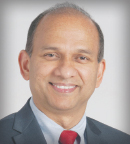
Jame Abraham, MD, FACP
Globally, breast cancer surpassed lung cancer as the most common cancer among women, with an estimated 2.3 million cases in 2020.1,2 Approximately 685,000 women will die of breast cancer in 2020 around the world. Approximately 24.5% of all cancers in women are breast cancer, and 15.5% of cancer-related mortality is due to breast cancer, making breast cancer the most common cancer diagnosis and the most common cause of cancer-related mortality globally. Most of this rise in incidence and mortality is occurring in low- and middle-income countries with limited screening infrastructure.
In this context, a study from India, reported by Indraneel Mittra, MD, PhD, and colleagues in BMJ 3 and reviewed in this issue of The ASCO Post, promises to have a tremendous impact. The study showed that clinical breast examination by health-care workers every 2 years was associated with a decrease in breast cancer–related mortality by 30% in women 50 years of age and older compared with active surveillance. In addition, in the intervention group, there was a significant downstaging of breast cancer at diagnosis, leading to a nonsignificant 15% reduction in breast cancer mortality among all women.
A Monumental Feat
This study is a monumental feat in many ways. It was conceived by Dr. Mittra, an eminent breast surgeon from Tata Memorial Centre, which is one of the largest cancer centers in Asia. He had the audacity to randomly assign about 150,000 women from Mumbai, the majority living in slums, who are historically skeptical of medical interventions. His group trained health-care workers to earn the trust and respect of these 150,000 women.
As per Dr. Mittra in his commentary in BMJ: “We used the premises of local political parties, community halls, and even a church where our female health-care workers could conduct clinical breast examinations. Screening 75, 000 women and actively monitoring the other 75,000 in the control arm by way of home visits every 2 years was a mammoth task. Women would often move residence, and it was up to our medical social workers to trace them to their new address. Women would often be unavailable when our female health-care workers and medical social workers visited, which then required multiple visits. From time to time, the Mumbai Municipal Corporation would decide to demolish a slum in order to redevelop it; as a result, several hundred women would suddenly disappear and had to be traced in other areas of the city. It was nothing short of a miracle that our medical social workers were able to trace them in their new homes. It is entirely to their credit that our overall compliance to screening was close to 70%—a very respectable achievement under the -circumstances.” 4
In addition to the sheer number of women who were followed by Dr. Mittra’s team for 20 years, the Tata Memorial Centre team functioned under limited resources. However, they were supported by a National Institutes of Health R01 grant in the first 15 years and funding from various sources later on.
Practice-Changing for Low- and Middle-Income Countries?
In the end, his group was able to prove that clinical breast examination by a trained health-care worker can decrease the risk of breast cancer mortality by 30% in women aged 50 years of age and older. This can be a practice-changing study for low- and middle-income countries. The health-care leaders in India and the rest of the world should learn from this and try to implement policies to increase early detection and downstaging, so we can improve mortality from breast cancer.
“In addition to the sheer number of women who were followed by Dr. Mittra’s team for 20 years, the Tata Memorial Centre team functioned under limited resources.”— Jame Abraham, MD, FACP
Tweet this quote
As Raj Badve, MBBS, MS, Director of Tata Memorial Centre, related to me in correspondence regarding the study findings: “I feel this offers a good opportunity for early detection for breast cancer in low- and middle-income countries. The scarce health-care delivery infrastructure will not be further burdened due to a lack of overdiagnosis. The results also give an alternative for those women globally who refuse to undergo mammographic screening (15%–30%).”
Dr. Abraham is Chairman of the Department of Hematology and Medical Oncology, Taussig Cancer Institute, and Professor of Medicine at Cleveland Clinic Lerner College of Medicine, Cleveland Clinic.
DISCLOSURE: Dr. Abraham has received institutional research funding from Pfizer and Seattle Genetics.
REFERENCES
2. World Health Organization (WHO): Global Health Estimates: Leading Causes of Death. Cause-Specific Mortality, 2000–2019. Available at who.int/data/gho/data/themes/mortality-and-global-health-estimates/ghe-leading-causes-of-death. Accessed March 9, 2021.
4. Mittra I: The story of the Mumbai breast screening study. The bmj opinion. Available at https://blogs.bmj.com/bmj/2021/02/24/the-story-of-the-mumbai-breast-screening-study. Accessed March 9, 2021.


